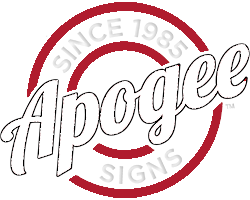 Do you ever feel like you’re drowning in a sea of confusing signage terms? Fear not! This comprehensive glossary is your life raft, offering clear definitions and explanations to help you navigate the vast world of signs. Whether you’re a seasoned sign professional or just starting your journey, this guide will equip you with the knowledge to confidently conquer the industry’s unique vocabulary.
Do you ever feel like you’re drowning in a sea of confusing signage terms? Fear not! This comprehensive glossary is your life raft, offering clear definitions and explanations to help you navigate the vast world of signs. Whether you’re a seasoned sign professional or just starting your journey, this guide will equip you with the knowledge to confidently conquer the industry’s unique vocabulary.
We’ll delve into everything from the fundamental types of signs to cutting-edge techniques used in the field. Our clear and concise explanations will empower you to make informed decisions when it comes to signage, allowing you to sail smoothly through the ever-changing landscape of this dynamic industry.
A B C D E F G H I J K L M N O P Q R S T U V W X Y Z
A
A-Frame Sign: Also known as a sandwich board sign, it is a portable sign consisting of two boards hinged at the top, forming an ‘A’ shape. Typically used to display messages or advertisements on sidewalks.
Acrylic Sign: A sign made from acrylic, a durable and versatile material that can be easily shaped, engraved, or printed on. Acrylic signs offer a sleek and professional appearance.
ADA-compliant: Refers to signage that adheres to the accessibility guidelines set forth by the Americans with Disabilities Act (ADA). ADA-compliant signs incorporate features such as braille, raised lettering, and proper color contrast to ensure accessibility for individuals with disabilities.
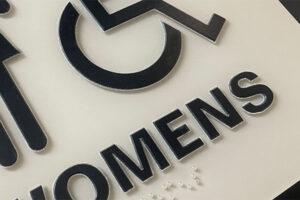 ADA Signs: Signs that comply with the Americans with Disabilities Act (ADA) regulations, designed to provide accessibility for individuals with disabilities. They include tactile lettering, Braille, and high contrast colors.
ADA Signs: Signs that comply with the Americans with Disabilities Act (ADA) regulations, designed to provide accessibility for individuals with disabilities. They include tactile lettering, Braille, and high contrast colors.
Adhesive Vinyl: Vinyl material with an adhesive backing that allows it to be easily applied to various surfaces, such as windows, walls, or vehicles. Adhesive vinyl is commonly used for lettering, decals, or full-color graphics.
Airblade Sign: A sign that utilizes a thin stream of air to create an interactive and eye-catching display. Airblade signs can be used to showcase floating objects, text, or images, creating a captivating visual experience.
Animated Sign: A sign that incorporates movement or animation to attract attention and engage viewers. Animated signs can use various techniques, such as LED displays, scrolling text, or rotating panels, to create dynamic visuals.
ANSI: The American National Standards Institute (ANSI) is a private nonprofit organization that develops voluntary consensus standards for various industries, including sign manufacturing and safety.
Anti-Graffiti Coating: A protective coating applied to signage surfaces to prevent or facilitate the easy removal of graffiti or vandalism. Anti-graffiti coatings provide an added layer of protection and simplify the cleaning process, preserving the integrity and appearance of the sign.
Architectural Signage: Signage designed to complement the architecture of a building or space. It includes signs integrated into the structure, such as lobby signs, monument signs, and directional signs.
Awning Sign: A sign attached to or painted on an awning, typically found on storefronts. It provides shade and protection from the elements while also serving as an advertisement.
B
Backer Panel: A solid panel placed behind a sign to provide contrast or support. Backer panels can be used to enhance the visibility and readability of the sign against its background.
Backlit Channel Letter: A three-dimensional channel letter sign with internal illumination that creates a halo effect or glow around the letters. Backlit channel letters are visually striking and enhance nighttime visibility.
Backlit Sign: A sign illuminated from behind, usually by LED lights or fluorescent tubes. The light source creates a halo effect, making the sign more visible in low-light conditions.
Banner: A flexible sign made of vinyl or fabric material, typically used for temporary outdoor advertising. Banners are often hung on poles or buildings and can display graphics, text, or both.
Banner Stand: A portable display stand specifically designed to hold banners for trade shows, events, or retail environments. Banner stands offer easy setup and allow for quick change-outs of banner graphics.
Billboard Advertising: Large, outdoor advertising structures typically located along highways, busy streets, or in high-visibility areas. Billboards offer a wide audience reach and are used to promote products, services, or events.
Blade Bracket: A mounting bracket used to attach a blade sign to a building or structure. Blade brackets provide stability and secure positioning of the sign.
Blade Flag: A tall, flag-shaped sign attached to a flexible pole that is commonly used for outdoor advertising, events, or promotions. Blade flags flutter in the wind, attracting attention and conveying messages.
Blade Sign: A sign mounted perpendicular to the building façade, projecting outward. It is commonly used to attract attention from pedestrians walking by a business.
Braille Sign: A sign that incorporates Braille characters, designed for individuals with visual impairments. Braille signs are typically required in public spaces to ensure accessibility and include tactile information.
Brushed Aluminum Sign: A sign made from aluminum sheets that have been mechanically or chemically brushed to create a textured or matte finish. Brushed aluminum signs provide a modern and sophisticated appearance.
Building Code: Regulations and standards set by local authorities that dictate the design, placement, and installation requirements for signs within a specific jurisdiction.
Bus Shelter Ad: Advertising displayed on shelters found at bus stops or transit stations. Bus shelter ads are strategically placed to capture the attention of pedestrians and commuters.
Building Directory: A sign or display located in a building’s lobby or entrance area that provides a list of businesses or occupants within the building, along with their corresponding floor or suite numbers.
Building Wrap: A large-scale vinyl or fabric sign that covers the entire exterior surface of a building, transforming it into a massive advertising display. Building wraps are attention-grabbing and offer high visibility in urban environments.
C
Carved Sign: A sign created by cutting or engraving a design into a material, such as wood, stone, or foam, to create a textured and dimensional effect. Carved signs are often used for high-end establishments, personalized plaques, or outdoor signage.
Cast Metal Sign: A sign created by pouring molten metal, such as aluminum or bronze, into a mold to form a solid, durable sign. Cast metal signs are often used for high-end or prestigious applications that require a classic and elegant look.
Changeable Letter Sign: A sign that allows for easy replacement or rearrangement of individual letters or characters to update messaging. Changeable letter signs are commonly used for marquee signs, menu boards, or price displays.
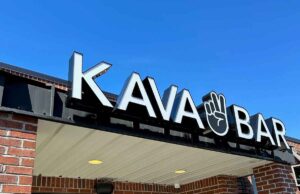 Channel Letter Sign: A channel letter sign is a three-dimensional sign with individually fabricated letters or shapes, often made of metal or plastic. The letters are illuminated internally and can be mounted directly to a building or on a raceway.
Channel Letter Sign: A channel letter sign is a three-dimensional sign with individually fabricated letters or shapes, often made of metal or plastic. The letters are illuminated internally and can be mounted directly to a building or on a raceway.
CNC Routing: Computer Numerical Control (CNC) routing is a manufacturing process that uses automated machines to cut and shape sign materials, such as wood, metal, or plastic, based on digital designs.
Column Wrap: A vinyl or fabric wrap that is applied to columns or pillars to transform their appearance or provide branding opportunities. Column wraps are commonly used in retail environments, event spaces, or architectural settings.
Compliance Signage: Signs that convey regulatory or safety information to ensure compliance with specific rules, laws, or standards. Compliance signage includes safety signs, warning signs, or instructional signs to promote adherence to guidelines or regulations.
Coroplast: A lightweight, corrugated plastic material commonly used for temporary outdoor signage, such as yard signs or event signs. It is durable and weather resistant.
Corrugated Plastic Sign: A lightweight, weather-resistant sign made from corrugated plastic sheets, commonly known as Coroplast. Corrugated plastic signs are affordable, durable, and frequently used for temporary signage or outdoor advertising.
Counter Display: A small display or sign placed on a countertop or checkout area to showcase products, promotions, or informational materials. Counter displays are designed to attract attention and encourage impulse purchases or engagement with the displayed content.
Cut Vinyl: A sign-making technique that involves cutting pre-colored vinyl into specific shapes or letters using a plotter cutter. The vinyl is then applied to a surface, creating a visually appealing design.
D
Decal: A thin, self-adhesive sticker or film used for signage purposes. Decals can be applied to various surfaces, such as windows, vehicles, or equipment, to display logos, graphics, or information.
Die-Cut Sign: A sign that is cut into a specific shape or design using a sharp steel rule or die. Die-cut signs offer custom shapes and intricate detailing, allowing for unique and visually appealing signage displays.
Dibond Sign: A rigid composite material made of two thin aluminum sheets bonded to a solid plastic core. Dibond signs are lightweight, durable, and weather-resistant, making them suitable for both indoor and outdoor signage applications.
Digital Printing: A printing method that transfers digital-based designs directly onto a substrate using inkjet or laser technology. Digital printing allows for high-quality prints, precise color reproduction, and quick turnaround times for signage production.
Digital Menu Board: An electronic display used in restaurants, cafes, or food establishments to present menus, pricing, or promotional content. Digital menu boards offer flexibility for easy updates, dynamic visuals, and the ability to customize menus based on time of day or specific promotions.
Digital Signage: Electronic displays, such as LCD or LED screens, used to present dynamic and customizable content, including images, videos, and text. Digital signage is often used for advertising, information dissemination, and wayfinding.
Dimensional Lettering: Three-dimensional letters or characters that are individually cut, molded, or fabricated to create a raised effect on signs. Dimensional lettering adds depth and visual interest to signage and can be made from materials such as metal, plastic, or foam.
Direct-View LED Display: A large-scale display that uses individual light-emitting diodes (LEDs) to create a high-resolution, bright, and vibrant visual experience. Direct-view LED displays are commonly used for outdoor advertising, stadiums, or large indoor venues.
Directional Sign: A sign that provides guidance or indicates the direction to a specific location, facility, or point of interest. Directional signs are commonly used in public spaces, parking lots, or large complexes to help individuals navigate and reach their desired destinations.
Directory Sign: A sign that lists and provides information about the occupants or businesses within a building, facility, or complex. Directory signs are typically found in lobbies, malls, or office buildings, facilitating wayfinding, and providing directory listings for visitors or customers.
Display Graphics: Visual elements, graphics, or images used in signs, banners, or displays to convey information, promote products, or enhance brand identity. Display graphics are designed to attract attention and communicate messages effectively.
Dot Matrix Display: A type of digital display that uses a grid of individual pixels or dots to form text, numbers, or simple graphics. Dot matrix displays are commonly used for information boards, transportation signs, or electronic scoreboards.
Dwell Time: The amount of time that a viewer spends looking at a particular sign or display. Dwell time is a crucial metric in measuring the effectiveness and engagement level of signage, as it determines the opportunity for the message to be seen and understood.
Dye-Sublimation: A printing process that uses heat to transfer ink onto a material, creating vibrant and durable graphics. Dye-sublimation is often used for fabric-based signage, such as banners or flags.
E
Eco-Friendly Signage: Signs that are designed and produced with environmentally friendly materials and practices to minimize their impact on the environment. Eco-friendly signage may incorporate recycled materials, use energy-efficient lighting, or employ sustainable production methods.
Edge-Lit Sign: A sign that utilizes LED lighting along the edges or sides of a transparent or translucent material to create a glowing effect. Edge-lit signs offer a sleek and modern appearance and are commonly used for illuminated displays or signage.
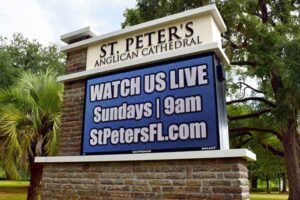 Electronic Message Center (EMC): Also known as a digital display or electronic sign, an EMC is a type of signage that uses LED or LCD technology to display dynamic content, including text, images, and animations.
Electronic Message Center (EMC): Also known as a digital display or electronic sign, an EMC is a type of signage that uses LED or LCD technology to display dynamic content, including text, images, and animations.
Electronic Reader Board: An electronic sign or display that can be programmed to show dynamic messages, announcements, or information. Electronic reader boards often use LED technology and can be updated remotely or scheduled for automatic content changes.
Embossed Sign: A sign with raised or recessed elements, adding texture and depth to the design. Embossing can be done on various materials, such as metal, plastic, or paper, to create a visually appealing effect.
Enamel Sign: A sign made from enamel; a durable glass coating fused onto metal. Enamel signs are known for their longevity, resistance to weathering, and classic vintage appeal, making them popular for retro or nostalgic branding.
Engraved Sign: A sign that features text, logos, or designs that are etched or carved into a material, such as wood, metal, or acrylic. Engraved signs offer a classic and permanent way to display information or branding.
Entrance Sign: A sign placed at the entrance of a property, building, or facility to identify its name, purpose, or ownership. Entrance signs create a favorable first impression and help visitors locate their destination easily.
Etched Glass Sign: A sign that features designs, text, or logos etched onto glass surfaces using acid, sandblasting, or laser etching techniques. Etched glass signs offer an elegant and professional appearance and can be used for interior signage or architectural features.
Exit Sign: A sign indicating the location of an emergency exit or a way out of a building. Exit signs are typically designed to be highly visible, even in low-light or smoky conditions, and often incorporate illuminated letters or symbols.
Exterior Signage: Exterior Signs are specifically designed and manufactured for outdoor use. They are constructed using materials and finishes that can withstand exposure to weather conditions, ensuring longevity and visibility.
Exhibition Graphics: Visual elements, graphics, or displays specifically designed for trade shows, exhibitions, or conferences. Exhibition graphics include banners, backdrops, booth designs, or promotional materials to attract attention and engage attendees.
Exhibition Stand: A display structure or booth used at trade shows, exhibitions, or events to showcase products, services, or branding. Exhibition stands can be customized to fit specific needs and provide a platform for engagement with potential customers or clients.
Eyelet: A small metal or plastic ring inserted into a hole in a banner or other flexible sign material. Eyelets are used to reinforce the holes and provide attachment points for ropes, bungee cords to a building or an overhead structure. Hanging signs are commonly used in pedestrian areas, shopping districts, or for storefront identification.
F
Fabricated Letters: Three-dimensional letters or logos created by cutting, bending, or welding metal, acrylic, or other materials. Fabricated letters provide a sophisticated and durable signage solution often used for corporate branding or high-end architectural projects.
Fabric Printing: The process of printing designs, graphics, or images onto various types of fabric materials for signage, banners, or displays. Fabric printing allows for vibrant colors, high-resolution prints, and a soft, textured appearance.
Fascia Sign: A sign that is mounted parallel to the building façade, typically above the storefront. Fascia signs often display the name or logo of a business and are visible to pedestrians and passing vehicles.
Feathering: A technique used in sign painting or lettering to create smooth transitions between colors or shades. Feathering involves blending or fading colors together gradually to achieve a soft, seamless appearance.
Feather Flag: A tall, narrow flag-shaped sign that is attached to a flexible pole and anchored to the ground. Feather flags are commonly used for outdoor advertising and can be customized with graphics and messages.
Flatbed Printer: A type of digital printer that allows direct printing onto flat or rigid surfaces, such as boards, acrylic, or metal sheets. Flatbed printers enable high-quality prints, including textured effects or layered prints for signage and displays.
Flex Face Sign: A large-format sign made from a flexible material, such as PVC or silicone-coated fabric. Flex face signs are commonly used for billboards and building wraps, offering versatility and easy installation.
Floor Graphics: Signs or graphics applied to the floor or ground surfaces, typically in high-traffic areas or retail environments. Floor graphics can convey promotional messages, directions, or branding, effectively utilizing the available space.
Fluorescent Sign: A sign illuminated using fluorescent lighting tubes. Fluorescent signs are known for their bright, even illumination and are often used in indoor settings, such as retail stores or offices.
Flush Mount Sign: A sign that is installed directly onto a surface, such as a wall or panel, with no visible mounting hardware or gaps. Flush mount signs provide a sleek and streamlined look, appearing as if they are seamlessly integrated into the surface.
Foamex: A lightweight, rigid sign material made from expanded PVC foam. Foamex is durable, weather-resistant, and suitable for both indoor and outdoor signage applications. It can be easily cut, shaped, and printed on.
Freestanding Sign: A self-supporting sign structure that is not attached to a building or other surface. Freestanding signs, such as pole signs or monument signs, are strategically placed to maximize visibility and provide clear identification or directional information.
Freeway Sign: Large-scale signs placed along highways or freeways to provide directional information, traffic guidance, or advertise upcoming exits or attractions. Freeway signs are designed to be highly visible from a distance and quickly convey important information to motorists.
Frosted Glass Film: A translucent film applied to glass surfaces to create a frosted or etched appearance. Frosted glass film is commonly used for privacy, decoration, or branding purposes on windows, doors, or partitions, while still allowing light to pass through.
Full-Color Printing: A printing process that utilizes a wide range of colors, tones, and shades to reproduce images or graphics with a high level of detail and accuracy. Full-color printing allows for vibrant, eye-catching signs that effectively convey messages or branding.
G
Gas Station Canopy Sign: A sign that is mounted on or integrated into the canopy structure above fueling stations at gas stations. Gas station canopy signs typically display branding, fuel prices, or promotional messages and provide visibility to passing motorists.
Glow-in-the-Dark Sign: A sign that is designed to emit light in the dark or low-light conditions due to the application of phosphorescent materials. Glow-in-the-dark signs enhance visibility and can be used for safety signage or emergency exit markings.
Giant Inflatable: An oversized, inflatable sign or structure that is often used for advertising or promotional purposes. Giant inflatables can be customized into various shapes, such as product replicas or mascots, to attract attention and create a memorable visual impact.
Gobo: A stencil or template that is placed in front of a light source to project a specific shape, pattern, or logo onto a surface. Gobos are commonly used in signage to create dynamic lighting effects or display branded images.
Graphic Design: The process of creating visual content, including layouts, typography, and imagery, for signs and other marketing materials. Graphic design plays a crucial role in effectively communicating messages and enhancing the visual appeal of signage.
Graphic Overlay: A layer of printed or laminated material that is applied on top of a sign or control panel to display symbols, icons, or information. Graphic overlays are often used in equipment, ap Gobo: A stencil or template that is placed in front of a light source to project a specific shape, pattern, or logo onto a surface. Gobos are commonly used in signage to create dynamic lighting effects or display branded images.
Grayscale: A range of shades between black and white, without color saturation. Grayscale is used in sign design and printing to represent images or graphics in a monochromatic format, allowing for variations in tone and contrast.
Green Signage: Signage that incorporates sustainable practices and materials to minimize environmental impact. Green signage may involve the use of eco-friendly substrates, energy-efficient lighting, or recyclable materials in the production process.
Grommet: A small metal or plastic ring inserted into a hole in a sign or banner to reinforce the hole and provide a secure attachment point. Grommets are often used in conjunction with ropes, zip ties, or bungee cords for hanging or mounting signage.
Grommet Press: A specialized tool or machine used to attach grommets to banners or other flexible sign materials. Grommet presses provide a fast and efficient way to reinforce holes in signage, ensuring secure installation and durability.
Ground-Mounted Sign: A sign that is installed directly into the ground, typically using posts, pylons, or other structural supports. Ground-mounted signs are commonly used for outdoor advertising, wayfinding, or identification purposes.
Guide Sign: A sign that provides directional information to guide people to specific destinations, such as highways, airports, or public facilities. Guide signs use standardized symbols, arrows, and textual information to assist with navigation and route planning.
Guillotine Cutter: A tool or machine used for cutting sign materials, such as vinyl, foam board, or acrylic, in a straight, precise manner. Guillotine cutters are manual or powered and feature a sharp blade that slices through the material.
H
Halo Effect: A lighting technique used in signage where the light source is positioned behind the sign, creating a glowing effect around the edges or behind the letters or graphics. The halo effect adds visibility and a distinctive look to the sign.
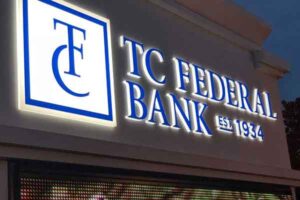 Halo-Lit Sign: A type of sign where the letters or elements are illuminated from behind, creating a halo effect or glow around the sign. Halo-lit signs provide a visually striking and elegant appearance, particularly at night.
Halo-Lit Sign: A type of sign where the letters or elements are illuminated from behind, creating a halo effect or glow around the sign. Halo-lit signs provide a visually striking and elegant appearance, particularly at night.
Hanging Hardware: Various components, such as hooks, chains, or cables, used to suspend signs from ceilings or other overhead structures. Hanging hardware ensures secure and attractive installations of suspended signs or displays.
Hanging Sign: A sign that is suspended from a bracket or other support structure, typically attached to a building or an overhead structure. Hanging signs are commonly used in pedestrian areas, shopping districts, or for storefront identification.
Hazard Sign: A sign that indicates potential hazards or risks in a particular area or environment. Hazard signs include symbols, icons, or text to alert individuals to potential dangers and promote safety awareness and compliance.
Header Sign: A sign that displays a prominent title, heading, or main message. Header signs are often used in retail settings, trade shows, or exhibitions to draw attention and categorize or highlight specific product areas.
Heat Transfer Vinyl: A type of vinyl material used in sign making, which can be cut into shapes or letters using a plotter cutter and then applied to a substrate using heat. Heat transfer vinyl is commonly used for textile and fabric signage.
High-Resolution Printing: Printing with a high level of detail and clarity, resulting in sharp and vibrant images. High-resolution printing is essential for producing visually appealing signs, especially those with intricate graphics or small text.
High-Rise Signage: Signage specifically designed for tall buildings or skyscrapers. High-rise signage utilizes large-scale graphics, LED displays, or illuminated elements to create impactful visual statements on the exterior or interior of tall structures.
Highway Signage: Signs specifically designed for use along highways, expressways, or major roadways to provide directional information, regulatory information, or safety messages. Highway signage helps guide motorists, convey important information, and promote road safety.
Hole Punching: The process of creating holes in signage materials to facilitate installation or attachment. Hole punching allows for easy placement of grommets, fasteners, or other mounting hardware to securely hang or display signs.
Holographic Signage: Signs that incorporate holographic technology to create three-dimensional or dynamic visual effects. Holographic signage is attention-grabbing and often used for promotional or immersive experiences.
I
Iconography: The use of symbols, icons, or pictograms to represent specific concepts, instructions, or information on signs. Iconography helps convey messages quickly and universally, transcending language barriers and enhancing visual communication.
Illuminated Sign: A sign that is internally or externally illuminated to enhance visibility, especially during low-light conditions. Illuminated signs can use various light sources, such as LED modules, fluorescent tubes, or neon.
In-Store Signage: Signs and displays used within retail environments to promote products, direct customers, or enhance the overall shopping experience. In-store signage includes window graphics, shelf talkers, point-of-sale displays, or promotional signage.
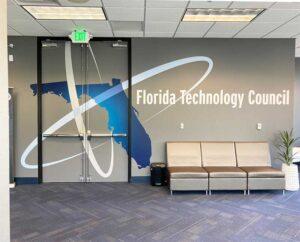 Indoor Signage: Signs specifically designed and manufactured for use in interior spaces. Indoor signage includes directional signs, room identifiers, menu boards, and informational displays found in offices, retail stores, or public buildings.
Indoor Signage: Signs specifically designed and manufactured for use in interior spaces. Indoor signage includes directional signs, room identifiers, menu boards, and informational displays found in offices, retail stores, or public buildings.
Inflatable Sign: A sign made of lightweight, inflatable materials, often filled with air or gas to create a three-dimensional display. Inflatable signs are portable, attention-grabbing, and commonly used for outdoor events, trade shows, or promotions.
Informational Sign: A sign that provides relevant information, instructions, or details about a specific topic, location, or process. Informational signs are commonly used in public spaces, transportation hubs, or facilities to inform and educate the audience.
Ingress/Egress Sign: A sign that indicates entry or exit points in a building, facility, or public area. Ingress/egress signs help individuals navigate and identify designated entry and exit paths, promoting safety and efficient traffic flow.
Inkjet Printing: A printing technology that uses inkjet nozzles to spray tiny droplets of ink onto a substrate, resulting in precise and high-quality prints. Inkjet printing is commonly used in sign making for producing graphics, text, and images.
Interactive Signage: Signage that allows user engagement or interaction through touchscreens, sensors, or other technologies. Interactive signage may provide information, gather data, or offer interactive experiences to captivate and engage viewers.
Interchangeable Sign: A sign that allows for the easy replacement or interchangeability of its content. This can be achieved through removable panels, inserts, or digital displays, allowing for flexible messaging or seasonal promotions.
Interior Illumination: Lighting techniques used to enhance the visibility and aesthetic appeal of signs placed indoors. Interior illumination may include LED lighting, neon lights, or backlighting to create a focal point and ensure signage stands out in indoor environments.
Inverted Corner Sign: A sign that is designed with an angled or inverted corner to fit snugly on a building or wall corner. Inverted corner signs maximize visibility from multiple directions and create a polished and aesthetically pleasing display.
J
J-Channel: A type of trim or molding used in sign installation. J-channels are typically made of metal or PVC and provide a secure track for inserting and holding sign panels, such as plastic or aluminum sheets.
J-Hook: A curved metal hook or hanger used to suspend or mount signage on walls, ceilings, or other surfaces. J-hooks provide a secure and adjustable means of hanging lightweight to medium-weight signs, allowing for easy installation and repositioning of signage displays.
J-Trim: A trim piece, typically made of metal or plastic, used to finish the exposed edges of sign panels or substrates. J-trim provides a clean and professional appearance, protecting the edges from damage.
Jet Printer: A type of large-format printer that uses inkjet technology to produce high-quality prints on various sign materials. Jet printers offer speed, precision, and vibrant color reproduction, making them suitable for signage production.
Jig: A specialized tool or device used to hold and guide materials during the fabrication or assembly of signs. Jigs ensure accuracy and consistency during the production process, particularly for repetitive tasks or complex designs.
Jittering: A design technique that involves intentionally introducing slight variations or irregularities in the lines, edges, or spacing of sign elements. Jittering adds a dynamic and lively effect to the sign design, enhancing visual interest.
Job Site Signage: Signs placed at construction or job sites to provide information, branding, safety instructions, or project details. Job site signage helps identify the project, showcase the contractors involved, and communicate important information to workers, visitors, and the public.
Job Ticket: A document or form that contains information related to a specific signage project, including specifications, instructions, scheduling, or client details. Job tickets help ensure efficient project management and accurate execution of sign production and installation.
Joining Strip: A strip or connector used to join multiple sign panels or substrates together, providing a seamless appearance. Joining strips can be made of various materials, such as aluminum, plastic, or PVC.
Jumbo Banner: An oversized banner typically used for large-scale outdoor advertising or events. Jumbo banners provide high visibility and can be customized with graphics, logos, or promotional messages.
Jumbo Screen: A large-scale LED display or video wall used for outdoor events, stadiums, or concerts. Jumbo screens provide high-resolution visuals and are commonly used to showcase live footage, advertisements, or interactive content.
Jumbotron: A large, high-resolution LED display typically used in sports stadiums, arenas, or outdoor venues to provide live video feeds, advertising, or informational content. Jumbo Tron’s offer high visibility and dynamic visual experiences.
Jump Scrolling: A scrolling effect used in digital signage where the content moves abruptly from one position to another, catching the viewer’s attention. Jump scrolling adds a dynamic and eye-catching element to digital signage displays.
Justified Text: A text alignment option where the lines of text are stretched or compressed to fit within a defined space, creating even margins on both the left and right sides. Justified text is commonly used in signage to achieve a neat and professional appearance.
K
Kapow Sign: A term used to describe signs or displays that feature dynamic, attention-grabbing visuals, often incorporating vibrant colors, bold typography, or eye-catching graphics. Kapow signs are designed to make a strong impact and capture viewers’ attention.
Keder System: A system used for attaching and tensioning fabric graphics to frames or structures. Keder systems involve inserting a flexible PVC or silicone strip (keder) into a groove or track, ensuring a secure and wrinkle-free display of fabric signage.
Keyboard Encoder: A device or circuit that translates keystrokes or inputs from a keyboard into specific signals or commands for digital signage systems. Keyboard encoders enable user interaction and control in interactive signage applications.
Keyhole Mounting: A mounting method for signs that involves creating keyhole-shaped slots or openings on the back of the sign. The sign can then be easily hung or mounted onto screws or nails protruding from the wall or surface.
Keying: The process of matching or aligning the colors of multiple graphic elements, such as logos or images, to ensure consistency and visual harmony in a sign design. Keying helps achieve a seamless integration of elements.
Key Account: A significant or strategically important client or customer for a sign company. Key accounts often have high volume, long-term contracts, or special requirements, and their satisfaction and loyalty are crucial to the success of the sign business.
Keypad Entry Sign: A sign that incorporates a keypad or numeric entry system to control access to a restricted area or facility. Keypad entry signs are commonly used for security purposes, requiring a passcode or PIN to gain entry.
Keytag Sign: A small, durable sign or tag typically attached to keychains, luggage, or other personal items. Keytag signs often display logos, contact information, or identification numbers, providing branding or identification purposes.
Kerbside Sign: A sign placed near the edge of a road or sidewalk to provide information, advertising, or directions. Kerbside signs are commonly used for businesses, events, or public facilities to attract attention from passing pedestrians or motorists.
Kiss-Cut: A cutting technique that cuts through the top layer of a material without fully penetrating the backing. Kiss-cutting is commonly used for creating stickers or labels that can be easily peeled away from the backing.
Kiosk: A freestanding interactive display unit used for self-service transactions or information dissemination. Kiosks often incorporate digital screens, touchscreens, and printers, making them suitable for various applications, including retail, wayfinding, or ticketing.
Knifeless Tape: A specialized adhesive tape used in the sign industry for cutting vinyl graphics without the need for a blade or cutter. Knifeless tape is applied along the desired cutting path, and tension is applied to create a clean, precise cut in the vinyl.
Knockout: The process of removing a specific shape or area from a background material, leaving a void or negative space. Knockouts are commonly used in signage to create cutout letters or graphics for layering or backlighting effects.
Knot-Free Mesh Banner: A type of banner material designed with a smooth surface that minimizes the appearance of visible knots or mesh patterns. Knot-free mesh banners offer enhanced image quality and are commonly used for large-scale outdoor advertising.
Krypton Sign: A type of illuminated sign that uses krypton gas within glass tubes or bulbs to create a distinctive and vibrant lighting effect. Krypton signs are often used for decorative or promotional purposes.
L
Lamination: A protective coating applied to the surface of a sign or graphic to enhance durability, weather resistance, and longevity. Lamination can be in the form of a clear film or liquid, providing a protective barrier against UV rays, moisture, and abrasion.
Large Format Printing: The process of printing on a larger scale, typically for signage, banners, or displays. Large format printing allows for high-resolution graphics, bold visuals, and the ability to create attention-grabbing designs on larger surfaces.
Laser Cutting: A precise cutting technique that uses a laser beam to cut through various sign materials, such as acrylic, wood, or metal. Laser cutting allows for intricate designs, sharp edges, and smooth contours.
Laser Engraving: The process of using a laser beam to etch or engrave designs, text, or graphics onto various sign materials. Laser engraving offers high precision, intricate detailing, and customization capabilities for producing signs with a permanent and professional appearance.
LED Module: A small electronic component that contains multiple light-emitting diodes (LEDs) and is used to form larger LED displays or signage. LED modules provide bright and uniform illumination, allowing for the creation of dynamic and eye-catching displays.
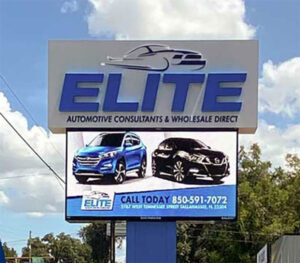 LED Screen: A display screen that utilizes Light-Emitting Diode (LED) technology for vibrant and high-resolution visuals. LED screens are commonly used for digital signage, video walls, or large-scale displays due to their brightness, energy efficiency, and flexibility.
LED Screen: A display screen that utilizes Light-Emitting Diode (LED) technology for vibrant and high-resolution visuals. LED screens are commonly used for digital signage, video walls, or large-scale displays due to their brightness, energy efficiency, and flexibility.
LED Sign: A sign that utilizes light-emitting diodes (LEDs) as the light source. LED signs offer energy efficiency, long lifespan, and vibrant illumination, making them popular for both indoor and outdoor applications.
Lenticular Sign: A sign that utilizes lenticular lens technology to create visual effects, such as 3D depth, motion, or image transition. Lenticular signs are eye-catching and engage viewers with dynamic and interactive visuals.
Letterbox Sign: A sign that features individual letters or graphics that are inserted into a recessed, box-like structure. Letterbox signs provide a three-dimensional effect and can be internally illuminated for enhanced visibility.
Lettering: The process of creating and applying individual letters or characters onto a sign or surface. Lettering can be achieved through various methods, such as vinyl cut lettering, hand painting, or dimensional letters.
Light Box: A sign enclosure that contains a translucent panel or face, often illuminated from behind using fluorescent lamps or LED lights. Light boxes are commonly used for displaying graphics, advertising, or informational messages.
Light Emitting Diode (LED) Signage: Signage that utilizes LED technology for illumination. LED signage offers energy efficiency, long lifespan, vibrant colors, and versatile display options, making it a popular choice for both indoor and outdoor applications.
Line of Sight: The direct visual path between a viewer and a sign. Line of sight is an important consideration when determining the placement and height of signage to ensure maximum visibility and impact.
Location Permit: A permit or license required by local authorities or governing bodies to install or display signage in a specific location. Location permits ensure compliance with regulations, safety standards, and zoning requirements.
Logo: A unique and identifiable graphic symbol or emblem representing a business, organization, or brand. Logos are often used in signage to visually communicate a company’s identity or establish brand recognition.
Low-Voltage Signage: Signage that operates on low voltage electrical systems, typically 12V or 24V. Low-voltage signage is energy-efficient, cost-effective, and often used for illuminated signs or displays.
Luminosity: The brightness or intensity of light emitted by a sign or illuminated display. Luminosity is a key factor in ensuring optimal visibility and readability, especially for outdoor or nighttime signage.
M
Magnetic Sign: A flexible sign made of magnetic material that adheres to metal surfaces. Magnetic signs are easily removable and are commonly used for vehicle signage, such as car door signs or magnetic truck signs.
Maintenance Agreement: A contract or agreement between a sign company and the client for ongoing maintenance and service of installed signage. Maintenance agreements ensure proper upkeep, repair, and regular inspection of signs to maintain their effectiveness and appearance.
Matte Finish: A non-glossy surface finish used in signage for a subdued or muted appearance. Matte finishes reduce glare and reflections, making them suitable for signs viewed under bright lighting conditions or for a sophisticated aesthetic.
Menu Board Display System: A comprehensive system that includes digital screens, software, and hardware to manage and display menus or pricing information in restaurants, cafes, or other food establishments. Menu board display systems offer flexibility, easy updates, and the ability to showcase visually appealing menu items.
Mesh Banner: A type of banner material with small perforations that allow wind to pass through, reducing the strain on the banner in outdoor environments. Mesh banners are commonly used for large-scale outdoor advertising or fence wraps.
Monochrome Signage: Signage that utilizes a single color or grayscale palette. Monochrome signage can be effective for minimalist designs, retro aesthetics, or to convey a specific mood or tone.
Monolith Sign: A tall, freestanding sign that typically features a single large structure or panel. Monolith signs are often used for wayfinding, entrance identification, or branding in outdoor settings.
Monument Sign: A large, freestanding sign typically positioned at ground level, often near the entrance of a property or development. Monument signs are durable and can feature various materials, such as stone, metal, or concrete.
Motion Sensor: A device that detects movement or motion and triggers a specific action or response, such as activating lighting or changing the content on a digital sign. Motion sensors are commonly used in signage for energy efficiency, interactivity, or security purposes.
Mounting Hardware: Various tools, fixtures, or brackets used to securely attach signs to surfaces, such as walls, poles, or ceilings. Mounting hardware includes screws, anchors, clamps, or brackets, providing stability and proper installation of signage displays.
Mural: A large-scale painted or printed image or artwork applied directly to a wall or surface. Murals are often used in signage to create visually appealing displays or to enhance the ambiance of a space.
N
Nameplate: A small, typically personalized sign that displays a person’s name, job title, or other identifying information. Nameplates are commonly used in office environments, medical facilities, or corporate settings.
Nano-coating: A thin, protective coating applied to the surface of signage to enhance durability, resistance to scratches, UV radiation, and other environmental factors. Nano-coatings offer increased longevity and maintain the original appearance of the signage.
Natural Signage: Signage that incorporates natural or organic elements, materials, or designs to blend harmoniously with the surrounding environment. Natural signage may use wood, stone, living plants, or other natural elements to create a visually pleasing and eco-friendly signage solution.
NEMA: The National Electrical Manufacturers Association (NEMA) is an industry association that establishes standards and guidelines for electrical equipment, including components used in signage, such as electronic message centers or lighting systems.
Neon Sign: A type of illuminated sign that uses glass tubes filled with neon gas, resulting in a bright and colorful lighting effect. Neon signs are popular for their distinctive and retro aesthetic.
Niche Signage: Signage that is specifically tailored to cater to a particular market, industry, or target audience. Niche signage may include specialized messaging, design elements, or materials that align with the unique needs and preferences of a specific niche.
Nighttime Visibility: The ability of a sign to be clearly seen and legible in low-light or night-time conditions. Nighttime visibility is crucial for ensuring the effectiveness and impact of illuminated or reflective signage.
Non-glare Signage: Signage with specialized coatings or finishes that reduce glare caused by ambient light sources. Non-glare signage ensures optimal visibility and readability, particularly in bright or high-contrast environments.
Non-Illuminated Sign: A sign that does not incorporate any form of internal or external lighting. Non-illuminated signs rely on external light sources or natural light for visibility and are commonly used for informational or directional purposes.
Non-Slip Floor Graphics: Vinyl graphics or decals designed for application on floors to provide visual cues, directions, or advertising. Non-slip floor graphics have a textured or laminated surface to prevent slipping and ensure safety.
Notice Sign: A sign that provides important information, warnings, or notices to inform individuals of specific rules, regulations, or policies. Notice signs are commonly used in public spaces, offices, or facilities to convey instructions, restrictions, or safety guidelines.
Nylon Bristle Brush: A cleaning tool used for maintaining and cleaning signs, especially those with textured or irregular surfaces. Nylon bristle brushes are gentle yet effective in removing dirt, dust, or debris without scratching the sign material.
O
Occupancy Sign: A sign that displays the maximum number of people allowed in a building, room, or space at a given time. Occupancy signs are essential for compliance with fire safety regulations and ensuring the safety of occupants.
Offset Sign Printing: A printing technique that utilizes an offset printing press, which transfers ink from a plate to a rubber blanket before transferring it onto the signage material. Offset printing provides accurate color reproduction, sharp details, and high-quality prints suitable for various sign applications.
OLED Signage: Signage that utilizes Organic Light-Emitting Diode (OLED) technology, which produces self-emitting pixels that emit light when an electric current is applied. OLED signage offers vibrant colors, high contrast, wide viewing angles, and thin form factors, making it suitable for various signage applications.
On-Premises Sign: A sign that is located on the property of a business, establishment, or organization, typically used to identify the business, advertise products or services, or convey information to visitors or customers.
One-Way Vision: A type of perforated vinyl material used for window graphics that allows visibility from one side while appearing opaque from the other side. One-way vision films are commonly used for vehicle wraps, storefronts, or bus advertising.
Outline Lighting: A lighting technique where light is placed around the outline or edges of a sign to create a halo effect or emphasize the shape of the sign. Outline lighting enhances visibility and adds a striking visual element to the signage.
Outdoor Advertising: Advertising displays or signs placed in outdoor locations, such as billboards, transit shelters, or bus wraps. Outdoor signs aim to reach a wide audience and generate brand awareness or convey specific messages.
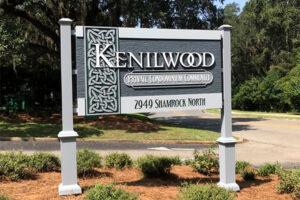 Outdoor Signage: Signs specifically designed and manufactured for use in outdoor environments. Outdoor signage is built to withstand exposure to weather conditions, UV radiation, and other outdoor elements.
Outdoor Signage: Signs specifically designed and manufactured for use in outdoor environments. Outdoor signage is built to withstand exposure to weather conditions, UV radiation, and other outdoor elements.
Overhead Sign: A sign mounted or suspended above a space or roadway to provide information, directions, or warnings. Overhead signs are often used on highways, bridges, or in large facilities to guide and inform traffic or pedestrians.
Overlaminate: A protective layer applied over a printed sign or graphic to provide additional durability, resistance to UV rays, and protection against wear and tear. Overlaminates are available in different finishes, such as gloss or matte, to enhance the appearance of the sign.
Oversized Graphics: Graphics or images that exceed standard sizes and dimensions, typically used for impactful displays, building wraps, or large-scale advertising. Oversized graphics command attention and provide maximum visibility to convey messages or promote brands effectively.
Oversize Load Banner: A large, highly visible banner typically placed on trucks or trailers carrying oversized or wide loads. Oversize load banners warn other drivers of potential hazards and comply with transportation regulations.
Outdoor LED Screen: A large-format LED display designed for outdoor environments, capable of withstanding exposure to weather conditions. Outdoor LED screens are commonly used for outdoor advertising, sporting events, concerts, or public displays due to their high brightness, durability, and wide viewing angles.
P
Pedestrian Wayfinding: Signage systems specifically designed to guide pedestrians through complex or crowded environments, such as shopping centers, airports, or campuses. Pedestrian wayfinding signage includes directional signs, maps, and symbols to ensure smooth navigation and enhance user experience.
Perforated Window Film: A specialized window film with tiny perforations that allow one-way visibility. Perforated window film is commonly used for storefront signage, vehicle wraps, or window graphics to display advertising while maintaining visibility from the inside.
Photopolymer Sign: A sign created using a photopolymer process, which involves exposing photosensitive materials to UV light to develop raised or textured images and text. Photopolymer signs are commonly used for ADA signage or tactile lettering.
Photoluminescent Signage: Signage that utilizes materials capable of absorbing and storing light energy, then emitting it as a glow in dark or low-light conditions. Photoluminescent signage enhances visibility during emergencies or power outages, ensuring safety and providing directional guidance.
Point of Purchase (POP) Display: Signage or promotional materials placed near the checkout area or point of sale to influence purchasing decisions. POP displays can include banners, product stands, or signage showcasing special offers or new products.
Portable Sign: A sign that is designed to be easily movable and transported. Portable signs are lightweight, often with wheels or handles, and provide flexibility for temporary advertising, events, or directional signage.
Post and Panel Sign: A sign consisting of one or more vertical posts supporting a panel or multiple panels. Post and panel signs are versatile and commonly used for directional signage, real estate signs, or informational displays.
Poster Printing: The process of printing images, graphics, or messages onto large-format posters for promotional or advertising purposes. Poster printing allows for high-quality prints on various materials and is commonly used for indoor displays, event promotions, or point-of-sale advertising.
Projection Sign: A sign that projects an image or message onto a surface using light or laser technology. Projection signs can create dynamic and eye-catching displays, especially in low-light environments or for special events.
Public Space Signage: Signs installed in public areas, parks, plazas, or community spaces to provide information, directions, regulations, or promotional messages. Public space signage helps create a welcoming environment and enhances the overall user experience.
Push-Through Letters: Three-dimensional letters or elements that are mounted on a sign face or panel and extend through pre-cut openings. Push-through letters create a dynamic, layered effect and allow for illumination from behind.
Pylon Sign: A tall, freestanding sign structure typically found near roadways or entrances to attract attention and provide visibility from a distance. Pylon signs often display multiple tenant names or logos and can incorporate illumination.
Q
QR Code: A Quick Response (QR) code is a two-dimensional barcode that can be scanned using a smartphone or QR code reader. QR codes are often used in signage to provide easy access to websites, promotions, or additional information.
Quantity Discount: A price reduction offered for purchasing a large quantity of signs or materials. Quantity discounts are commonly provided to customers who order signage in bulk, encouraging larger orders and cost savings.
Quality Assurance: Processes and procedures implemented to ensure that signage meets predetermined quality standards and specifications. Quality assurance involves thorough inspections, testing, and adherence to quality control measures throughout the production and installation process.
Quality Control: Processes and measures implemented to ensure that signs meet predetermined quality standards. Quality control in the sign industry involves inspections, testing, and adherence to specifications to deliver consistent and reliable signage.
Quarterboard Sign: A sign installed on the corner of a building or structure, typically showcasing the name or address of the establishment. Quarterboard signs are commonly used for commercial properties, historic buildings, or seaside locations.
Queue Management System: A system that uses signage, barriers, or digital displays to guide and organize people in waiting lines or queues. Queue management systems improve customer flow, reduce wait times, and enhance the overall customer experience in various settings, such as banks, airports, or retail stores.
Quick Change Frame: A sign frame designed for quick and easy graphic changes. Quick change frames typically feature snap or slide mechanisms that allow the sign face or graphic to be easily replaced without disassembling the entire frame.
Quick-Dry Ink: Ink specially formulated for rapid drying, reducing the wait time and allowing for faster production of signs. Quick-dry ink is commonly used in printing processes to enhance productivity and minimize smudging or smearing.
Quick Response Code: Also known as QR code, it is a two-dimensional barcode that can be scanned using a smartphone or QR code reader to access information, websites, or promotions related to the signage. QR codes are commonly used in signage for interactive and convenient engagement with customers.
Quick Sign: Pre-designed or pre-printed signs that are readily available and can be quickly installed or displayed. Quick signs are commonly used for temporary events, sales promotions, or informational messages that require immediate deployment.
Quiet Zone Sign: A sign used to designate areas or zones where noise levels must be minimized or controlled. Quiet zone signs are commonly used in hospitals, libraries, or residential areas to promote peace, tranquility, and compliance with noise regulations.
Quoting: The process of providing a price estimate or quotation for a sign project or job. Quoting involves assessing factors such as materials, design complexity, labor, and any additional services required to determine the cost of the signage project.
R
Real Estate Sign: A sign used to advertise properties for sale, lease, or rent. Real estate signs typically feature information such as the property’s availability, contact details, or the real estate agent’s branding.
Reflective Signage: Signs with materials or coatings that reflect light, increasing visibility and legibility in low-light conditions. Reflective signage is commonly used for traffic signs, safety signs, or outdoor signs to enhance visibility at night or in poor weather conditions.
Reflective Tape: A tape or film that contains reflective properties, often used on signs or surfaces to increase visibility, especially in low-light or nighttime conditions. Reflective tape improves the conspicuity of signage, enhancing safety and readability.
Reflective Vinyl: A type of vinyl material that contains tiny glass beads or reflective elements, allowing the sign to reflect light when illuminated. Reflective vinyl is commonly used for traffic signs, safety signage, or signs requiring high visibility in low-light conditions.
Regulatory Compliance: Adherence to local, regional, or national regulations, standards, or codes related to signage. Regulatory compliance ensures that signage meets specific requirements for safety, visibility, accessibility, content, or placement, as mandated by governing authorities.
Regulatory Sign: Signs that convey mandatory instructions or regulations to ensure compliance with specific rules or laws. Regulatory signs include speed limit signs, stop signs, no-entry signs, and other signs that inform and guide behavior on roads, highways, or public areas.
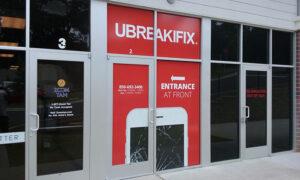 Retail Signage: Signage specifically designed for retail environments to attract customers, provide information, or promote products and services. Retail signage includes window displays, shelf talkers, point-of-purchase signs, or promotional banners to enhance the visual appeal and influence customer behavior.
Retail Signage: Signage specifically designed for retail environments to attract customers, provide information, or promote products and services. Retail signage includes window displays, shelf talkers, point-of-purchase signs, or promotional banners to enhance the visual appeal and influence customer behavior.
Retractable Banner Stand: A portable display stand that features a roll-up mechanism, allowing a banner or graphic to be easily rolled up and stored within the stand for convenient transportation. Retractable banner stands are commonly used for trade shows, events, or point-of-sale displays.
Reverse Cut: A sign-making technique where the letters or graphics are cut out of the background material, creating a negative space effect. Reverse-cut signs are often backlit to showcase the cutout elements and provide a visually striking display.
RGB: Acronym for “Red, Green, Blue,” the primary colors used in additive color mixing. RGB is commonly used in digital signage, LED displays, or screen-based graphics to create a wide range of colors by combining different intensities of red, green, and blue light.
Rigging: The process of installing or suspending signs using ropes, cables, or other means of support. Rigging is an essential aspect of sign installation, ensuring proper positioning, stability, and safety of the sign structure.
Roadside Sign: A sign placed along roadways or highways to convey information, directions, or advertising messages to passing motorists. Roadside signs can include billboards, directional signs, or promotional signage for businesses located near the road.
Roll-Up Banner: A portable and retractable banner display that uses a spring-loaded mechanism to retract the banner into a compact base for easy transportation and storage. Roll-up banners are popular for trade shows, events, and point-of-sale advertising.
Routed Letters: Three-dimensional letters or graphics that are precision-cut or carved out of sign materials using a router. Routed letters provide a clean, professional appearance and are commonly used for dimensional signage.
Router: A power tool equipped with a rotating cutting bit used to hollow out or carve grooves in sign materials, such as wood, plastic, or metal. Routers are versatile tools for creating intricate designs, beveled edges, or decorative accents on signs.
Router Bit: A cutting tool specifically designed for routing or engraving sign materials. Router bits are available in various shapes and sizes to achieve different cutting effects, such as beveled edges, V-grooves, or intricate designs.
S
Safety Signs: Signs that provide information, warnings, or instructions to promote safety in various environments. Safety signs include symbols, pictograms, or text and are commonly used in workplaces, public areas, or construction sites to ensure the well-being of individuals.
Sandblasting: A technique used to etch or carve designs into materials, such as glass, stone, or wood, by forcefully propelling abrasive particles against the surface. Sandblasting creates a textured or frosted effect on signage, adding visual interest and depth.
Sandwich Board Sign: A portable, A-frame sign that resembles a sandwich board when open, with display areas on both sides. Sandwich board signs are commonly used for sidewalk advertising, menu displays, or promotional messaging, allowing easy setup and changeable content.
Screen Printing: A printing technique that involves transferring ink onto a substrate using a mesh screen. Screen printing is commonly used for large-scale signage projects, producing vibrant and durable prints with high color opacity.
Sidewalk Sign: A portable sign designed for placement on sidewalks or footpaths to attract attention and communicate messages to pedestrians. Sidewalk signs are often A-frame or sandwich board-style signs that can be easily moved and provide flexibility for displaying promotions or daily specials.
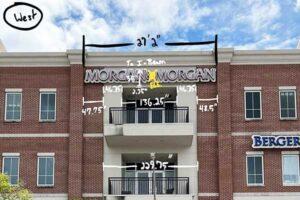 Site Survey: An assessment conducted to gather information about the physical location where signage will be installed. A site survey includes measurements, analysis of environmental factors, and identification of any obstacles or requirements necessary for the successful installation of signage.
Site Survey: An assessment conducted to gather information about the physical location where signage will be installed. A site survey includes measurements, analysis of environmental factors, and identification of any obstacles or requirements necessary for the successful installation of signage.
Silkscreen Printing: A printing method that uses a stencil and ink to transfer designs onto a substrate. Silkscreen printing is often used for producing signs with flat, solid colors and can be applied to various materials, including metal, glass, or plastic.
SMD LED: Surface-Mount Device (SMD) LEDs are small, compact light-emitting diodes commonly used in LED signage. SMD LEDs are soldered directly onto circuit boards, providing bright and efficient illumination for digital displays and signs.
Solvent Printing: A printing technique that utilizes solvent-based inks to produce durable and weather-resistant prints on a variety of sign materials. Solvent printing is commonly used for outdoor signage, vehicle wraps, or banners requiring long-term outdoor exposure.
Static Cling Sign: A sign made of a thin, flexible material that adheres to smooth surfaces, such as glass, without the need for adhesive. Static cling signs are easily removable, repositionable, and commonly used for temporary promotions, window displays, or vehicle signage.
Step and Repeat Banner: A large backdrop banner featuring repeated logos, patterns, or graphics. Step and repeat banners are commonly used at events, red carpet occasions, or press conferences to provide a branded background for photo opportunities.
Street Sign: A sign used to indicate the name of a street, road, or avenue. Street signs are typically mounted on poles or affixed to buildings to aid navigation and provide clear identification of specific locations.
Sublimation Printing: A printing technique that uses heat and pressure to transfer dye onto signage materials, creating vibrant, long-lasting, and high-resolution prints. Sublimation printing is commonly used for fabric.
Substrate: The material or surface onto which signage is applied
T
Tactile Signage: Signs that incorporate raised letters, braille, or other tactile elements to provide information for visually impaired individuals. Tactile signage ensures accessibility and compliance with disability regulations, allowing people with visual impairments to navigate and access information independently.
Teardrop Banner: A unique banner shape resembling a teardrop, designed to flutter and attract attention even in low-wind conditions. Teardrop banners are often used for outdoor advertising, events, or promotions.
Tension Fabric System: A sign or display system that uses stretchable fabric graphics attached to a lightweight frame or structure. Tension fabric systems offer easy assembly, versatility, and the ability to create large-scale, seamless visuals.
Totem Sign: A tall, freestanding sign typically featuring multiple panels or faces with branding, directional information, or advertisements. Totem signs are often used in outdoor settings, such as shopping centers or business complexes, to provide visibility and serve as landmarks.
Touchscreen Display: A digital display equipped with touch-sensitive technology that allows users to interact directly with the screen. Touchscreen displays are commonly used in interactive kiosks, information panels, or wayfinding systems.
Trade Show Display: A specialized sign or booth used to showcase products, services, or brands at trade shows or exhibitions. Trade show displays often incorporate banners, signage, backdrops, and interactive elements to attract visitors and promote engagement.
Traffic Control Sign: Signs used to regulate, guide, and inform drivers or pedestrians about traffic regulations, hazards, or road conditions. Traffic control signs include stop signs, yield signs, speed limit signs, and construction zone signs, contributing to safe and organized traffic flow.
Translucent Signage: Signage that allows light to pass through, creating a soft, diffused glow. Translucent signage is often used with backlighting or internal illumination to create eye-catching and visually appealing displays.
Traffic Sign: Signs used on roadways to provide information, warnings, or regulations to drivers and pedestrians. Traffic signs include regulatory signs, warning signs, and guide signs, serving to ensure safety and proper traffic flow.
Truck-Mounted Sign: A sign that is mounted on a truck or trailer, often used for mobile advertising or promotional purposes. Truck-mounted signs can be static or digitally displayed and are effective in reaching a wide audience while on the move.
Typography: The art and technique of arranging and designing typefaces, fonts, and text elements in signage to convey a specific visual style, brand identity, or message. Typography plays a crucial role in sign design, affecting readability, legibility, and overall aesthetics.
U
Underpass Signage: Signs installed in tunnels or underpasses to provide directional information, safety instructions, or other relevant messages to motorists or pedestrians. Underpass signage helps navigate and ensure a smooth flow of traffic.
Under Construction Sign: A temporary sign placed at construction sites to inform and warn people of ongoing construction activities. Under construction signs typically display safety information, contact details, and instructions for accessing alternative routes.
Underground Signage: Signs installed in underground spaces such as subways, tunnels, or parking garages to provide directions, safety information, or identification. Underground signage ensures efficient navigation and visibility in areas where traditional signage may not be as easily accessible or visible.
Unframed Sign: A sign that does not have a traditional frame or border. Unframed signs provide a minimalist or contemporary appearance and often feature sleek edges or clean-cut designs.
Unlit Sign: A sign that does not incorporate any form of internal or external lighting. Unlit signs rely on external light sources for visibility and are commonly used in well-lit areas or during the daytime.
Upright Sign: A vertically oriented sign, typically taller than it is wide, mounted on a freestanding structure or pole. Upright signs are commonly used for wayfinding, directional signage, or as landmarks in outdoor settings.
Urban Wayfinding: Signage systems designed to guide pedestrians and motorists in urban environments, such as cities or downtown areas. Urban wayfinding signage includes directional signs, maps, landmarks, and other visual cues to improve navigation and enhance the visitor experience.
User Experience (UX) Design: The process of designing signage with a focus on creating a positive and seamless experience for users. UX design considers factors such as readability, ease of navigation, clear messaging, and the overall interaction between the signage and the audience.
UV Coating: A clear protective coating applied to the surface of a sign or graphic and cured using ultraviolet light. UV coating enhances durability, adds a glossy or matte finish, and provides resistance against fading, scratching, and weathering.
UV Printing: A printing process that uses ultraviolet (UV) light to cure or dry the ink instantly. UV printing offers vibrant colors, sharp details, and the ability to print on a wide range of materials, making it ideal for signage applications.
UV Protection: Coatings or films applied to signage materials to protect against the damaging effects of ultraviolet (UV) radiation from the sun. UV protection prolongs the lifespan of signs by preventing fading, discoloration, or deterioration caused by prolonged exposure to sunlight.
V
Vandal-Resistant Signage: Signs designed and constructed to withstand deliberate damage or tampering. Vandal-resistant signage features durable materials, secure mounting systems, and protective measures to prevent unauthorized removal or defacement, ensuring longevity and maintaining the intended message.
Vector Graphics: Graphics created using mathematical equations to define lines, shapes, and curves. Vector graphics can be scaled without loss of quality, making them ideal for signage applications where precise and scalable artwork is required.
Vehicle-Mounted Sign: A sign that is permanently affixed to a vehicle, such as a truck, van, or car, for promotional or identification purposes. Vehicle-mounted signs can be customized with logos, contact information, or advertising messages, turning vehicles into mobile billboards.
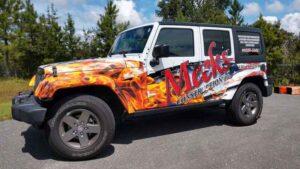 Vehicle Wrap: A vinyl film applied to the surface of a vehicle, completely or partially, to transform its appearance or serve as mobile advertising. Vehicle wraps can feature graphics, images, and text, providing a cost-effective and impactful marketing tool.
Vehicle Wrap: A vinyl film applied to the surface of a vehicle, completely or partially, to transform its appearance or serve as mobile advertising. Vehicle wraps can feature graphics, images, and text, providing a cost-effective and impactful marketing tool.
Video Wall: An arrangement of multiple display screens or monitors tiled together to create a larger, unified video display. Video walls are commonly used in digital signage applications to showcase dynamic content or advertisements.
Vinyl Lettering: Pre-spaced, cut-out letters or graphics made from adhesive vinyl material. Vinyl lettering is commonly used for creating custom signs, vehicle graphics, window displays, and interior wall decals.
Vinyl Banner: A flexible, durable, and weather-resistant banner made from vinyl material. Vinyl banners are commonly used for outdoor advertising, events, or temporary signage due to their versatility, affordability, and ability to withstand various weather conditions.
Visual Hierarchy: The arrangement and organization of visual elements in a sign to guide viewers’ attention and convey information effectively. Visual hierarchy involves prioritizing elements such as size, color, contrast, and placement to create a clear and visually appealing hierarchy of information.
Vitrine Display: A display case with transparent glass panels used to showcase products, artifacts, or exhibits. Vitrine displays are commonly used in retail stores, museums, or galleries to highlight valuable or delicate items.
W
Wall-Mounted Sign: A sign that is affixed directly to a wall or vertical surface. Wall-mounted signs can be made of various materials and are commonly used for directional signs, branding, or informational displays in indoor or outdoor settings.
Wall Graphics: Large-scale graphics or murals applied directly to walls or other flat surfaces. Wall graphics can transform interior spaces, enhance branding, and convey messages, making them popular in retail stores, offices, and public spaces.
Wall Wrap: A large-scale graphic or advertisement applied directly to a wall or vertical surface, completely transforming the appearance of the space. Wall wraps are commonly used for branding, murals, or promotional displays in retail stores, offices, or public areas.
Warning Sign: A sign that alerts individuals to potential hazards, dangers, or risks in a specific area or situation. Warning signs often use standardized symbols and colors to convey their messages effectively.
Waterproof Signage: Signs designed to withstand exposure to water or moisture without damage or deterioration. Waterproof signage is commonly used for outdoor applications, bathrooms, swimming pools, or areas prone to high humidity or wet conditions.
Wayfinding Signage: Signs strategically placed to provide directional guidance and assist people in navigating through unfamiliar environments. Wayfinding signage includes maps, arrows, symbols, and clear instructions to help individuals reach their destinations.
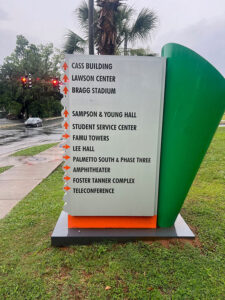 Wayfinding System: A comprehensive signage system designed to assist and guide people through complex environments, such as hospitals, airports, or large buildings. Wayfinding systems use a combination of signage, maps, symbols, and directions to ensure easy navigation and reduce confusion.
Wayfinding System: A comprehensive signage system designed to assist and guide people through complex environments, such as hospitals, airports, or large buildings. Wayfinding systems use a combination of signage, maps, symbols, and directions to ensure easy navigation and reduce confusion.
Waypoint Sign: A sign that indicates specific locations or landmarks along a route or trail, assisting travelers or hikers in navigation. Waypoint signs are often used in outdoor settings, such as parks, trails, or hiking areas.
Weather Resistance: The ability of a sign or sign material to withstand exposure to various weather conditions, including rain, snow, wind, sunlight, or extreme temperatures. Weather-resistant signs are designed to maintain their integrity and visibility in outdoor environments.
Wide Format Printing: Printing technology capable of producing large-scale graphics and signage, typically wider than traditional printing methods. Wide format printing allows for high-resolution prints on various materials, including vinyl, fabric, and rigid substrates.
Window Cling: A type of signage material that adheres to glass surfaces using static electricity, allowing for easy application, removal, and repositioning. Window clings are commonly used for temporary promotions, sale announcements, or window displays.
Wireframe: A skeletal framework or outline of a sign or graphic design, typically represented by lines or basic shapes. Wireframes help visualize the layout, structure, and placement of elements before the final design is created.
Wrap Installation: The process of applying a vinyl wrap to a vehicle, wall, or other surfaces. Wrap installation requires skill and precision to ensure a smooth, bubble-free application and proper adhesion of the vinyl.
Wrinkle-Resistant: A characteristic of certain sign materials, such as fabric or vinyl, that resist wrinkling or creasing. Wrinkle-resistant materials are commonly used for tension fabric displays, backdrops, or banners that require smooth and wrinkle-free surfaces.
X
X-Acto Knife: A precision cutting tool with a sharp, replaceable blade, often used in sign fabrication for intricate cutting, trimming, or detail work. X-Acto knives allow for precise control and clean cuts on various sign materials.
X-Banner Stand: A lightweight and portable banner stand featuring a frame in the shape of an “X.” X-banner stands are commonly used for displaying banners or signage in trade shows, conferences, or retail environments.
X-bracing: A structural technique in sign construction that uses diagonal or crossed bracing elements to enhance stability, strength, and resistance to external forces. X-bracing is commonly used in larger signs or freestanding structures.
X-Frame Banner Stand: A lightweight and portable banner stand featuring a collapsible frame in the shape of an “X.” X-frame banner stands are easy to set up and transport, making them suitable for trade shows, conferences, or retail environments.
X-height: In typography, the height of the lowercase letter “x” in relation to other letters in a font. X-height is an important factor in sign design, affecting readability and overall visual balance of text.
X-stand: A display stand that features a frame in the shape of an “X” and holds a graphic or sign. X-stands are commonly used for smaller signage applications, such as tabletop displays, retail promotions, or events.
Xylene: A solvent commonly used in the sign industry for cleaning surfaces, removing adhesive residue, or prepping substrates before application. Xylene is effective for removing stubborn marks or contaminants from sign materials.
Xenon Sign: A type of illuminated sign that uses xenon gas within glass tubes to create a bright and intense lighting effect. Xenon signs are known for their vibrant colors and are often used for commercial or decorative purposes.
Xenon Lighting: A lighting technology that uses xenon gas to produce a bright, white light commonly used in illuminated signage. Xenon lighting offers high visibility, long lifespan, and is often used in outdoor or architectural signage displays.
XML: Extensible Markup Language (XML) is a markup language commonly used for managing and storing data related to signage content, such as text, images, or formatting. XML allows for structured and customizable data organization.
XML Integration: The process of integrating XML (Extensible Markup Language) data into digital signage systems to dynamically display content, such as real-time information, news feeds, or social media updates. XML integration allows for automated and dynamic content updates on digital signage displays.
X-Y Plotter: A computer-controlled device used for precise cutting, drawing, or plotting of designs onto various materials, including signage substrates. X-Y plotters offer accuracy and versatility in creating intricate designs, lettering, or graphics for signage production.
Xylene: A solvent commonly used in the sign industry for cleaning surfaces, removing adhesive residue, or prepping substrates before application. Xylene is effective for removing stubborn marks or contaminants from sign materials.
Xylography: The art or technique of woodblock printing, where designs or text are carved into a wooden block and used for printing images onto signage or other materials. Xylography can create unique and intricate designs, adding a traditional or artistic touch to signs.
Y
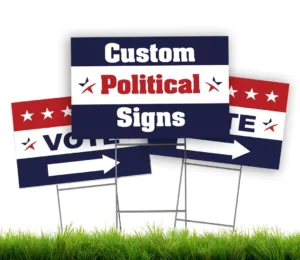 Yard Sign: A small, lightweight sign typically made of corrugated plastic and placed on lawns or outdoor areas to convey messages, such as political campaigns, real estate advertisements, or event announcements. Yard signs are easily visible and can be customized with graphics and text.
Yard Sign: A small, lightweight sign typically made of corrugated plastic and placed on lawns or outdoor areas to convey messages, such as political campaigns, real estate advertisements, or event announcements. Yard signs are easily visible and can be customized with graphics and text.
Year-Round Signage: Signs designed and installed to be displayed and maintained throughout all seasons and weather conditions. Year-round signage is constructed with durable materials and finishes to withstand temperature fluctuations, moisture, and UV exposure.
Yield Line: A painted or marked line on the road that indicates the point where drivers must yield or give way to oncoming traffic or pedestrians. Yield lines are used to ensure safe and orderly traffic flow and are typically found at intersections or merging lanes.
Yield Sign: A regulatory traffic sign that indicates drivers must yield the right-of-way to other vehicles or pedestrians at intersections or specific road situations. Yield signs are designed to ensure safe and efficient traffic flow.
Z
Zero Energy Signage: Signage systems that utilize renewable energy sources, such as solar panels or wind turbines, to power lighting or digital displays. Zero energy signage promotes sustainability and reduces reliance on traditional power sources.
Zigzag Display Stand: A versatile and portable display stand with multiple hinged panels that can be arranged in a zigzag or accordion-style configuration. Zigzag display stands provide a compact and flexible solution for showcasing graphics, product information, or promotional materials.
Zigzag Fold Brochure: A brochure folding style in which the paper is folded in a zigzag pattern, creating multiple panels or sections for displaying information or graphics. Zigzag fold brochures are commonly used for marketing materials or informational handouts.
Z-Shape Fold: A folding technique used for creating multi-panel brochures or informational signs. The Z-shape fold involves folding the material into alternating “Z” or accordion-like sections, allowing for compact storage and convenient unfolding to reveal the content.
Zone-based Digital Signage: A digital signage strategy that involves dividing a physical space into distinct zones or areas and displaying targeted content in each zone. Zone based digital signage allows for customized messaging and content delivery to different sections or areas within a larger display, maximizing engagement and relevance for viewers.
Zoning Regulations: Local government regulations that dictate the allowable size, placement, and design of signage within specific zones or districts. Zoning regulations aim to maintain aesthetic appeal, safety, and consistency in signage throughout a particular area.
Zone Signage: Signage that divides or designates specific areas or zones within a larger space or facility. Zone signage is helpful for organizing and directing people to different sections, departments, or services.
Zünd Cutter: A precision cutting system used in the sign industry for cutting various sign materials, including vinyl, foam board, acrylic, and more. Zünd cutters offer automated cutting capabilities and can handle intricate designs and patterns with high accuracy.
We hope that our sign industry glossary of terms serves as an invaluable resource for anyone seeking to navigate the language and concepts of the signage industry. We strive to make the definitions and explanations provided shed light on the diverse and dynamic world of signs.
As the signage industry continues to evolve and innovate, new terms and techniques will emerge. We understand that our glossary is just the beginning, and we encourage you to stay curious and explore further. Keep an eye on the ever-changing landscape of signage, as new concepts and technologies emerge to shape the future of visual communication.
We are committed to keeping our glossary up to date, ensuring that it remains a reliable reference for industry professionals, business owners, and enthusiasts alike. We welcome your feedback and suggestions, as your insights contribute to the ongoing improvement and expansion of our glossary.
Contact Us Today
If you’re ready to take your business to the next level with a custom commercial sign, contact us today to schedule a consultation. Our team of experts will work with you to design a sign that meets your specific needs and exceeds your expectations.
